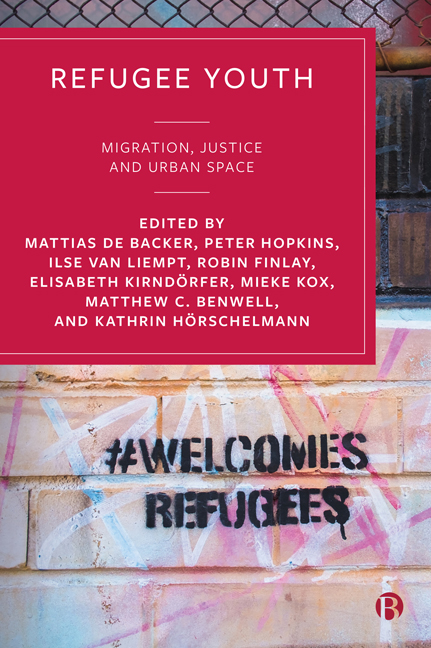Book contents
- Frontmatter
- Contents
- List of Figures and Tables
- Notes on Contributors
- Acknowledgements
- 1 Introducing Refugee Youth: Migration, Justice and Urban Space
- 2 Storying Belonging, Enacting Citizenship? (Dis)articulations of Belonging in a Community Theatre Project with Young Refugees and Asylum Seekers in Leipzig, Germany
- 3 Jackets and Jewellery: Racialised Dispossession and Struggles over Public Space in Denmark
- 4 Venezuelan Refugee Youth and Brazilian Schooling: The Individual between Languages and Spaces
- 5 The Inclusionary Potential and Spatial Boundaries of (Semi-)Public Space: Refugee Youth’s Everyday Experiences in the Urban Fabric of Amsterdam
- 6 Navigating ‘Purdah’ Culture in Urban Space: The Restricted Lives of Young Married Rohingya Refugees in Malaysia
- 7 Inclusive Urban Planning and Public Space for Refugee Youth in Pursuit of a Just City in Amman, Jordan
- 8 Sense of Belonging among Tibetan Refugees in India: A Case Study of the Bylakuppe Settlement in Karnataka, India
- 9 Negotiating Identity in Urban Space: Everyday Geographies of Syrian Students in Istanbul
- 10 ‘You’re Judged a Lot’: Australian Sudanese and South Sudanese Youths’ Perspectives on Their Experiences in Public Spaces
- 11 Hair Salons as ‘Private-Public Spaces’: Exploring the Experiences of Young Migrant Women in an Urban Township in South Africa
- 12 Emotion and Spatial Belonging: Exploring Young Migrant Men’s Emotional Geographies in Cork, Ireland
- 13 Homemaking through Music in Urban Africa: Creating Opportunities as a Refugee and a Migrant in Kinshasa and Dar es Salaam
- 14 Planetary Listening
- 15 Refugee Youth: Politics, Publicness and Visibility
- Index
2 - Storying Belonging, Enacting Citizenship? (Dis)articulations of Belonging in a Community Theatre Project with Young Refugees and Asylum Seekers in Leipzig, Germany
Published online by Cambridge University Press: 18 January 2024
- Frontmatter
- Contents
- List of Figures and Tables
- Notes on Contributors
- Acknowledgements
- 1 Introducing Refugee Youth: Migration, Justice and Urban Space
- 2 Storying Belonging, Enacting Citizenship? (Dis)articulations of Belonging in a Community Theatre Project with Young Refugees and Asylum Seekers in Leipzig, Germany
- 3 Jackets and Jewellery: Racialised Dispossession and Struggles over Public Space in Denmark
- 4 Venezuelan Refugee Youth and Brazilian Schooling: The Individual between Languages and Spaces
- 5 The Inclusionary Potential and Spatial Boundaries of (Semi-)Public Space: Refugee Youth’s Everyday Experiences in the Urban Fabric of Amsterdam
- 6 Navigating ‘Purdah’ Culture in Urban Space: The Restricted Lives of Young Married Rohingya Refugees in Malaysia
- 7 Inclusive Urban Planning and Public Space for Refugee Youth in Pursuit of a Just City in Amman, Jordan
- 8 Sense of Belonging among Tibetan Refugees in India: A Case Study of the Bylakuppe Settlement in Karnataka, India
- 9 Negotiating Identity in Urban Space: Everyday Geographies of Syrian Students in Istanbul
- 10 ‘You’re Judged a Lot’: Australian Sudanese and South Sudanese Youths’ Perspectives on Their Experiences in Public Spaces
- 11 Hair Salons as ‘Private-Public Spaces’: Exploring the Experiences of Young Migrant Women in an Urban Township in South Africa
- 12 Emotion and Spatial Belonging: Exploring Young Migrant Men’s Emotional Geographies in Cork, Ireland
- 13 Homemaking through Music in Urban Africa: Creating Opportunities as a Refugee and a Migrant in Kinshasa and Dar es Salaam
- 14 Planetary Listening
- 15 Refugee Youth: Politics, Publicness and Visibility
- Index
Summary
Introduction
Participatory theatre has, in a wide body of work, been discussed as an artistic format that bears the potential to enhance processes of participation, empowerment and resistance – especially when involving participants who experience marginalisation and racialisation in their societies (Butterwick and Selman, 2012, 2020; Chou et al, 2015; Sonn et al, 2015; Erel et al, 2017; Stam, 2020). The articulation of marginalised knowledges is considered to be an enactment of citizenship insofar as it uncovers oppressive structures and interrupts hegemonic regimes of belonging and citizenship that, ultimately, exert violence on racialised subjects (Butterwick and Selman, 2012, p 62; Stam, 2020, p 290). Participatory theatre can, in this sense, even serve as a decolonising practice (Perry, 2012; Erel and Reynolds, 2014; Sonn et al, 2015), especially in a societal climate that is increasingly marked by ‘divisive politics and racism’ (Butterwick and Selman, 2020, p 35). For newcomers such as young refugees and asylum seekers, participatory theatre provides a valuable resource in the process of negotiating arrival, engaging in and with a new place and connecting with other newcomers and longer-term residents in the city.
Personal stories and the practice of storytelling play a decisive role within participatory theatre (Kaptani and Yuval-Davis, 2008; Chou et al 2015; Sonn et al, 2015; Erel et al, 2017; Stam, 2020). They appear to be the basic tool for acting against racialisation and othering, for challenging disenfranchising citizenship regimes and for enhancing transformative processes from below. Working with story-based theatre can, however, ‘be risky, even harmful’ insofar as it can ‘trigger unremembered and unprocessed stories and memories’ (Butterwick and Selman, 2012, p 62). Despite this acknowledgement by Butterwick and Selman (2012), there has to date been little discussion in the literature on the complicated nature of ‘storying’, sharing emotional, closeup and personal narrative in the context of participatory theatre. Hence, what is largely missing is a critical focus on the (im)possibilities of speech, on moments of silence and disarticulation. In this chapter, I will investigate the ambiguities and ambivalences that accompany the key practice of storytelling, of sharing personal stories in participatory theatre, especially when involving ‘mixed groups’ such as, in our case, young refugees and asylum seekers as well as other newcomers to the city. My aim is to provide a detailed analysis of a participatory theatre process in which I engaged as participant observer.
- Type
- Chapter
- Information
- Refugee YouthMigration, Justice and Urban Space, pp. 14 - 31Publisher: Bristol University PressPrint publication year: 2023



